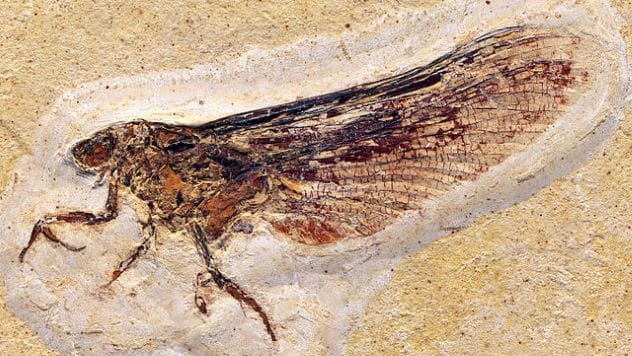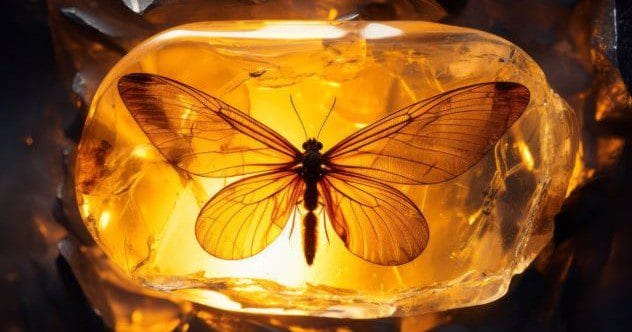Insects are everywhere! They are the most diverse group of creatures on the planet, boasting over 900,000 identified species of insects. It is thought that insects evolved around 480 million years ago, around the same time plants made their move to land. The fossil record of this evolution is somewhat patchy—but many fascinating fossil insects have been discovered. Let’s explore ten of the most intriguing discoveries.
Butterfly Scales
Butterflies and moths are delicate organisms that flutter through the air on wings coated with minuscule scales, belonging to an order of insects called Lepidoptera. The scales provide a number of benefits, the most obvious being their ability to scatter light, creating vivid colors and patterns. This is achieved through tiny structures on their surface that diffract light.
Fossilized scales are the oldest evidence of moths and butterflies ever discovered, dating back around 200 million years ago. They were recovered from a 10g sample of sediment dug up in Germany, once sitting at the bottom of a lagoon. From this one sample, seven different species of Lepidoptera were discovered.
Lacewing Larvae
Amber is the perfect medium for preserving ancient insects. When an insect becomes engulfed in sticky sap, its life might end, but its afterlife might be guaranteed. The sap solidifies and undergoes chemical changes to become amber—and the exterior of the insects is perfectly preserved.
One hundred million years ago, the predatory larvae of a lacewing fly had the bad luck of crawling into some sap. Today, lacewing larvae feed on soft and easy prey, but these ancient ones had long and sharp mouthparts, which suggests they hunted animals that needed to be kept at a distance, in case they fought back.
Ancient Insect Camouflage
Many insects are masters of camouflage, used to hide insects from predators or from their prey. Camouflage can take many forms, but perhaps the strangest that insects employ is wearing dead bodies to disguise themselves. Assassin bug larvae will pile the corpses of ants onto their backs.
This debris-carrying behavior has evolved multiple times in various insect lineages and has been captured in amber at times. In one case, the larva of a lacewing from over 100 million years ago was seen with dismembered parts of other arthropods stacked on its back. Another insect larva, named Hallucinochrysa diogenesi, was found to have draped filaments from a plant over itself.
The Insect Alien
You never know what insects will emerge from amber deposits, and sometimes, the results can be terrifying. One researcher discovered an insect fossil that looked like a science fiction alien, so he crafted a Halloween mask resembling it. He had to take the mask off, however, after it scared trick-or-treaters who visited his home too much.
The insect, dating to around 100 million years ago, was so bizarre that it was decided that it belonged to a wholly unknown order of insects known as the Aethiocarenodea. Discovering a new order of insects is incredibly rare despite there being nearly a million species of insects, they all belong to just 32 orders.
The new insect—Aethiocarenus burmanicus—is marked by a triangular head, which has only a narrow attachment to the body. By turning its head, the insect would have been able to see directly behind itself.
Insect with Bulging Eyes
Being able to see behind you by turning your head is pretty cool, but what about having 360-degree vision at all times? For that, you need either lots of eyes or eyes that are weirdly shaped and positioned. An insect trapped in amber has been discovered that has a pair of eyes that stick out from its head like light bulbs, giving it this unique ability.
Palaeotanyrhina exophthalma used its full range of vision to help it hunt for prey. Once located, the insect moved in and snatched them up with its modified front legs. These had special glands that produced a sticky substance that would have snared whatever it managed to grasp. It’s ironic then that this sticky-hunter came to a sticky end of its own when it wandered into sap.
Insect Ears
Bats have been blamed for a number of changes in insect evolution. Many bats feast on flying insects, so an evolutionary arms race has developed between bats looking to hunt them and insects seeking to avoid becoming a meal. By studying fossils that date before the evolution of bats, we know that several insect groups had developed a keen sense of hearing.
Well-preserved fossils of crickets and katydids from 50 million years ago show the same organs of hearing located behind the knees as modern species. This means that they must have evolved before bats appeared on the scene. The ability of insects to hear has evolved at least 17 different times in history due to the different strategies that different groups use to pick up sound.
The “Frankenstein” Insect

Even insects acted differently in the past. Today, mayflies are known for their strange life cycles, where they spend the majority of their time as larvae and emerge as adults for just a few hours or days. In that brief time, all they do is mate and produce the next generation of mayflies—they don’t even eat. Yet fossils of an early relative suggest things were not always this way.
Called Coxoplectoptera, dating to around 120 million years ago have been described as Frankenstein creatures because they join together features never before seen in a single species. Their wings were like those of a dragonfly, though with the vein pattern on the wings of a mayfly, and they had the front legs of a praying mantis.
Pollen-Carrying Insects
When we think of insects as pollinators of plants, we probably picture happy little bees flitting from flower to flower. But flowers probably only evolved around 140 million years ago, and we have evidence of insects carrying pollen that date from 280 million years ago.
By examining hundreds of fossils of an insect called tillyardembiids, researchers realized that six of them had pollen stuck to their heads, bodies, and legs. It is thought that the insects climbed into the cones of conifers and ate the pollen that they found there. The pollen came from a narrow range of species, which suggests the insects were specialized feeders.
The Oldest Insect Fossil
In the 1920s, a fossil was discovered in Scotland that dated to around 400 million years ago. Unfortunately, it was tiny and only a small fragment of the whole organism. In 2004, it was re-examined, and researchers were startled to discover that it matched insects today.
The fossil of Rhyniognatha hirsti is essentially just the mouth parts of the animal. The mandibles of the creature are triangular in shape and look very much like those belonging to flying insects. There are no fossils of flying insects from before 325 million years ago, but this fossil might hint that flying evolved much earlier than we had thought.
Insect in Opal
Opals are among the most spectacular precious stones found on Earth, with their vivid colors that shimmer as you move them. In one case, an opal astounded people; it was a fossil insect. This seems to be incredibly unlikely, potentially impossible because opal usually forms from small balls of silica settling in water.
In the example from Java, dating to around six million years ago, the insect can be clearly seen. You can even see its open jaws, antennae, and the minuscule hairs on it. There are many questions as to how this fossil could have formed, and many models have been proposed. Since the appearance of the first insect in opal, a second example has been recovered from the same site in Java.
These ten ancient insect fossils offer us a glimpse into the deep history of life on Earth, showcasing the incredible diversity and evolutionary adaptations of insects over millions of years. From insects trapped in amber to those preserved in opal, each discovery reveals unique insights into prehistoric ecosystems and the ongoing story of evolution.
What do you think about these insects? Leave your comment below!










